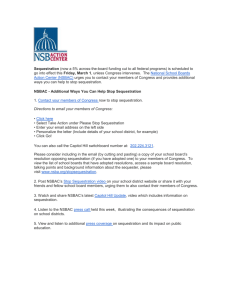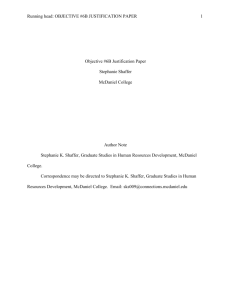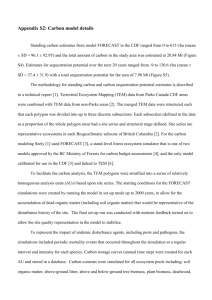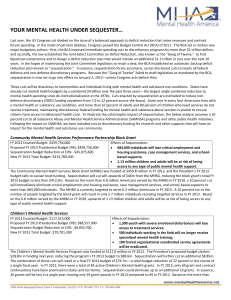Biological Carbon Sequestration Meeting Notes 05-22-2009
advertisement
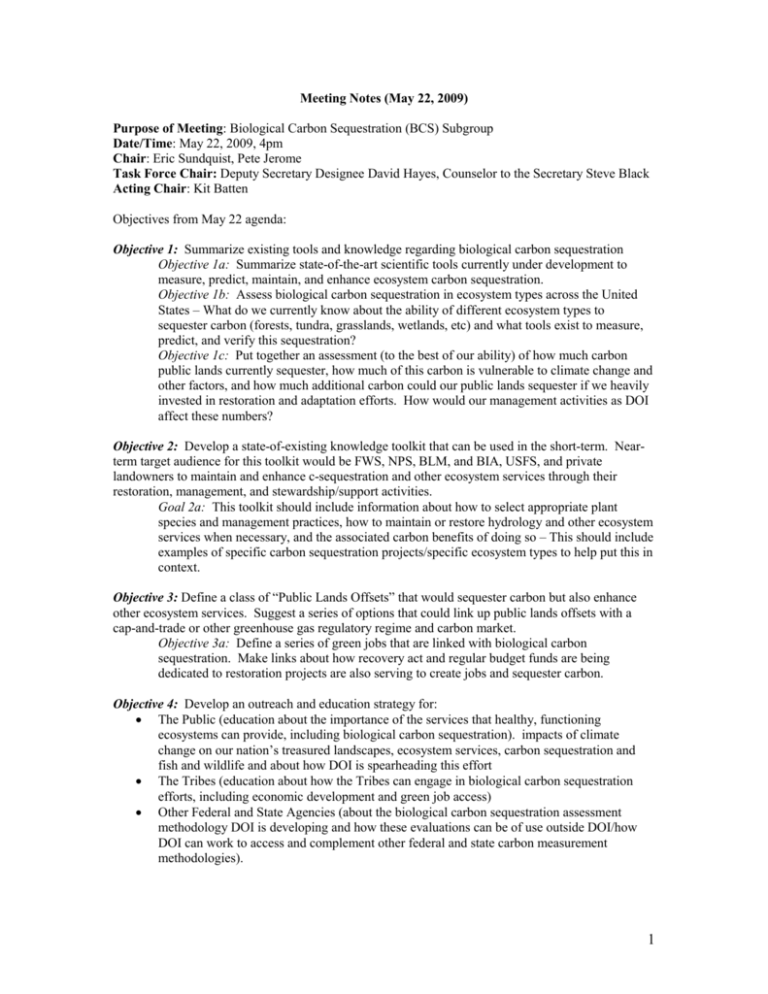
Meeting Notes (May 22, 2009) Purpose of Meeting: Biological Carbon Sequestration (BCS) Subgroup Date/Time: May 22, 2009, 4pm Chair: Eric Sundquist, Pete Jerome Task Force Chair: Deputy Secretary Designee David Hayes, Counselor to the Secretary Steve Black Acting Chair: Kit Batten Objectives from May 22 agenda: Objective 1: Summarize existing tools and knowledge regarding biological carbon sequestration Objective 1a: Summarize state-of-the-art scientific tools currently under development to measure, predict, maintain, and enhance ecosystem carbon sequestration. Objective 1b: Assess biological carbon sequestration in ecosystem types across the United States – What do we currently know about the ability of different ecosystem types to sequester carbon (forests, tundra, grasslands, wetlands, etc) and what tools exist to measure, predict, and verify this sequestration? Objective 1c: Put together an assessment (to the best of our ability) of how much carbon public lands currently sequester, how much of this carbon is vulnerable to climate change and other factors, and how much additional carbon could our public lands sequester if we heavily invested in restoration and adaptation efforts. How would our management activities as DOI affect these numbers? Objective 2: Develop a state-of-existing knowledge toolkit that can be used in the short-term. Nearterm target audience for this toolkit would be FWS, NPS, BLM, and BIA, USFS, and private landowners to maintain and enhance c-sequestration and other ecosystem services through their restoration, management, and stewardship/support activities. Goal 2a: This toolkit should include information about how to select appropriate plant species and management practices, how to maintain or restore hydrology and other ecosystem services when necessary, and the associated carbon benefits of doing so – This should include examples of specific carbon sequestration projects/specific ecosystem types to help put this in context. Objective 3: Define a class of “Public Lands Offsets” that would sequester carbon but also enhance other ecosystem services. Suggest a series of options that could link up public lands offsets with a cap-and-trade or other greenhouse gas regulatory regime and carbon market. Objective 3a: Define a series of green jobs that are linked with biological carbon sequestration. Make links about how recovery act and regular budget funds are being dedicated to restoration projects are also serving to create jobs and sequester carbon. Objective 4: Develop an outreach and education strategy for: The Public (education about the importance of the services that healthy, functioning ecosystems can provide, including biological carbon sequestration). impacts of climate change on our nation’s treasured landscapes, ecosystem services, carbon sequestration and fish and wildlife and about how DOI is spearheading this effort The Tribes (education about how the Tribes can engage in biological carbon sequestration efforts, including economic development and green job access) Other Federal and State Agencies (about the biological carbon sequestration assessment methodology DOI is developing and how these evaluations can be of use outside DOI/how DOI can work to access and complement other federal and state carbon measurement methodologies). 1 In attendance: Agency First Name Last Name FWS FWS FWS MMS MMS BIA BIA BIA NPS NPS USGS Pete Kurt Casey Brad Melisa Brian John Dr. Gary David Chris Eric USGS BLM BLM PMB PMB PMB BIA Bea Mike Bill Jonathan Christian Ben John Jerome Johnson Stemler Blythe Batum Kummet DeGroot Morishima Graber Shaver Sundquist Van Horne Pellant Ypsilantis Steele Crowley Simon Vitello Email Phone pete_jerome@fws.gov Kurt_Johnson@fws.gov casey_stemler@fws.gov brad.blythe@mms.gov melissa.batum@mms.gov briank@nezperce.org jdegroot@nezperce.org morikog@aol.com david_graber@nps.gov chris_shaver@nps.gov esundqui@usgs.gov 404 679 7157 303 236 4412 208 621 4619 208 843 7328 206 963 5651 bvanhorne@usgs.gov mike_pellant@blm.gov 208 373 3805 bill_ypsilantis@blm.gov 202 452 0339 jonathan_steele@ios.doi.gov Christian.crowley@ios.doi.gov benjamin_simon@ios.doi.gov John.vitello@bia.gov Objective 2(mostly) & 3 (lead) 2&4 4 4 3&4 3 4 1 1 (lead) 4 (lead) 2 1(mostly) 3 3 (lead) 4 (lead) Discussion Summary Topic: Objective Assignments Objective groups will outline elements of each objective and resubmit to the group at large. (Please see table above for objective assignments) Topic: Online Portal Neal Cooper, Sunny Bhagowalia, and Tim Quinn have taken on the responsibility of creating a portal where the Task Force information (subgroup info and general info that is applicable across agencies) will available for viewing and editing. Topic: Composition of Draft Products for June 17-18 meeting Should include compilation of existing knowledge about Biological Carbon Sequestration-an assessment of how much carbon is currently sequestered on public lands and the potential for additional carbon sequestration. Toolkit: o The group needs to outline what will be featured in the toolkit e.g. what we do know about data collection methods for BCS, what we don’t know, a path for producing future products (including budget and timeline). o The group also needs to synthesize existing info with respect to methodology, how different ecosystems sequester carbon, how much they could sequester with different management techniques, etc. o The group needs to decide which agencies to consult in the creation of the toolkit and also include an outline for how we should/shall tackle outreach and education 2 Topic: Life Cycle Analysis Between now and June 17-18, this group will focus on sequestration of carbon through restoration and conservation management practices. In the future this group could also consider an explanation of the many different types of sequestration and also opportunities for conversion e.g. building materials, biochar etc. Topic: Economic Concerns The group will also need to highlight economic concerns interlaced between all of the objectives but economic analysis will not be the focus of this group between now and June 17-18. Green jobs created by stimulus funds or budget process as a result of BCS should be included Topic: Data The group should have a common format for data collection. Perhaps a spreadsheet that can list data/information that is already know or that is unknown. Topic: BCS/restoration/adaptation nexus The group should identify habitats that are important for purposes of restoration, adaptation to climate change, and need additional attention regarding stopping the loss of carbon Groups should provide a narrative about what they know about the carbon sequestration properties for different ecosystem types-where appropriate. Group should also determine general/best management practices associated with each of these ecosystem types, both for BCS and for the enhancement of other important ecosystem services. 3
